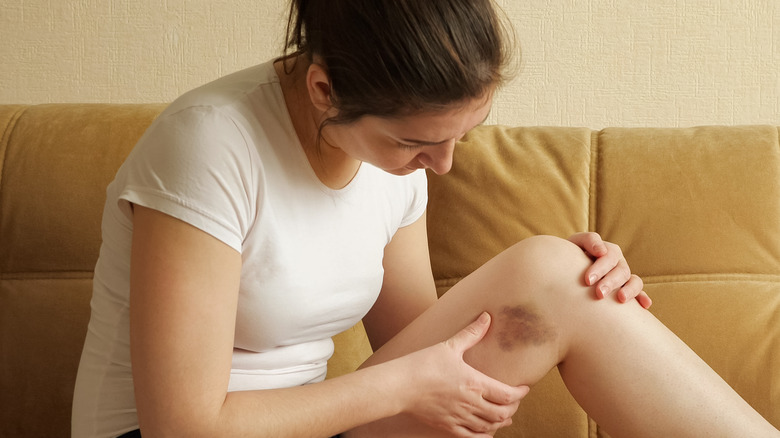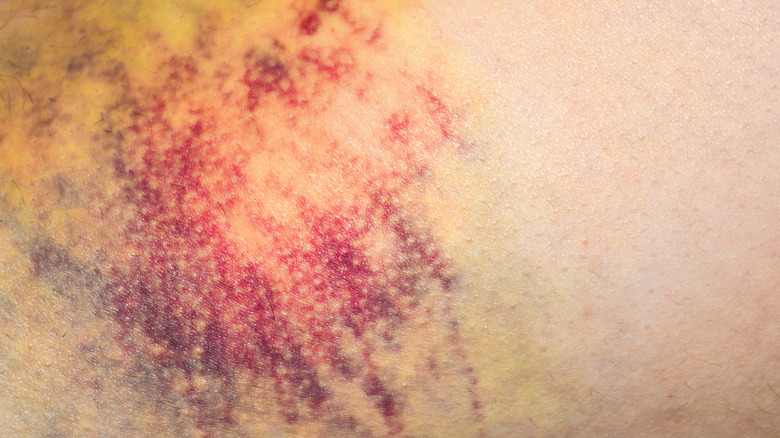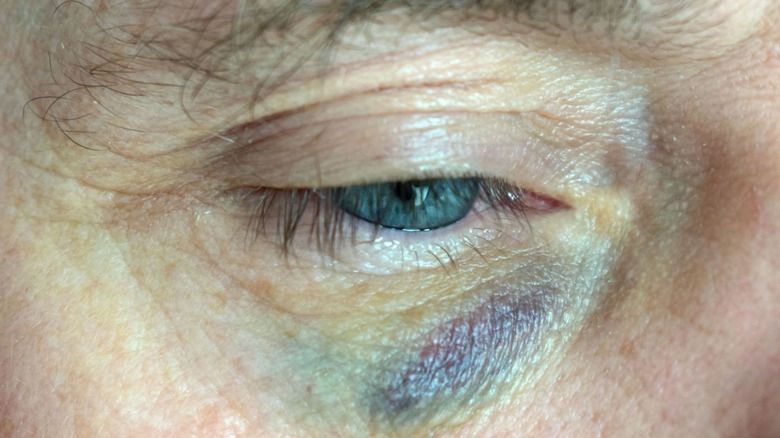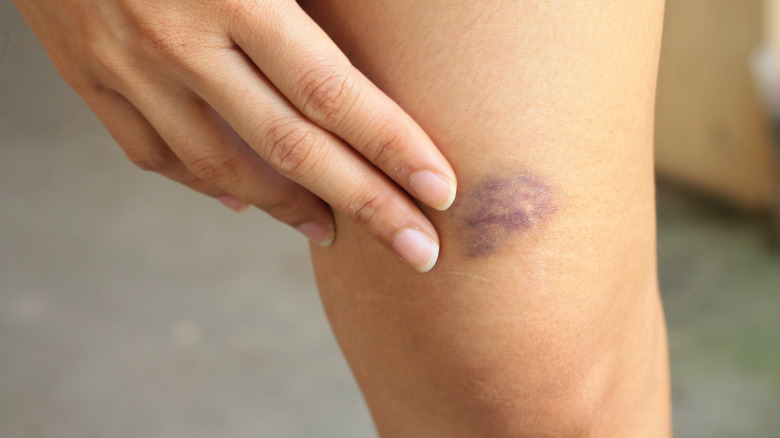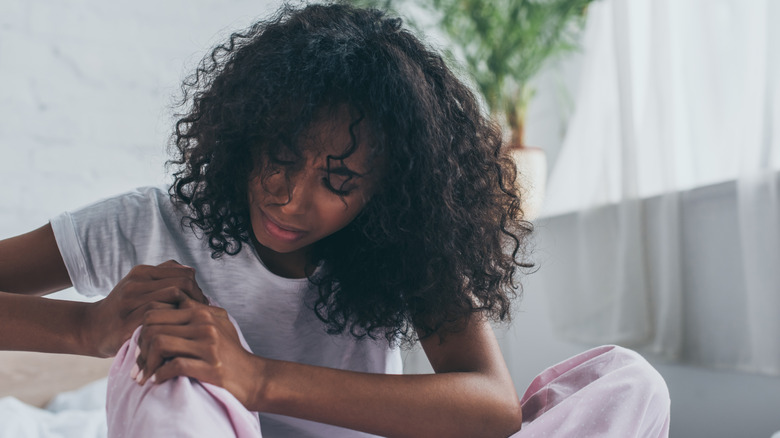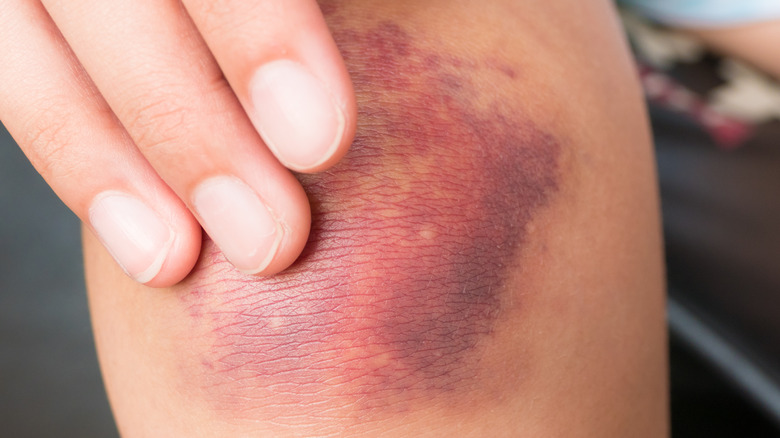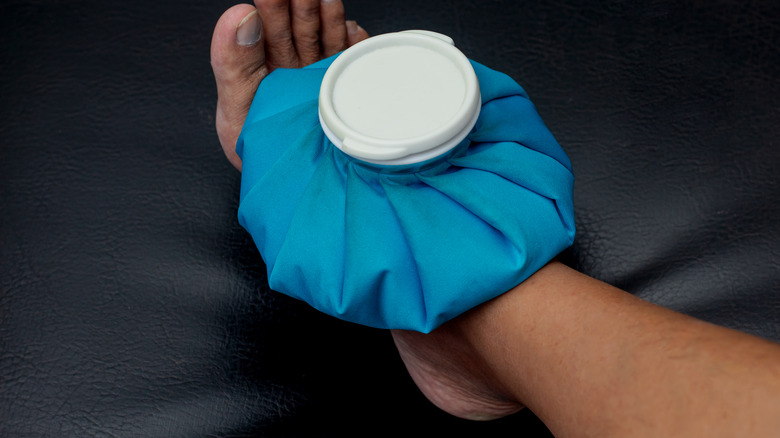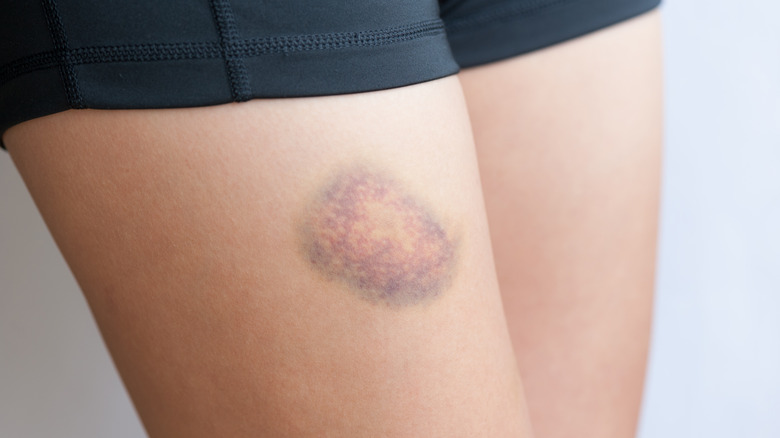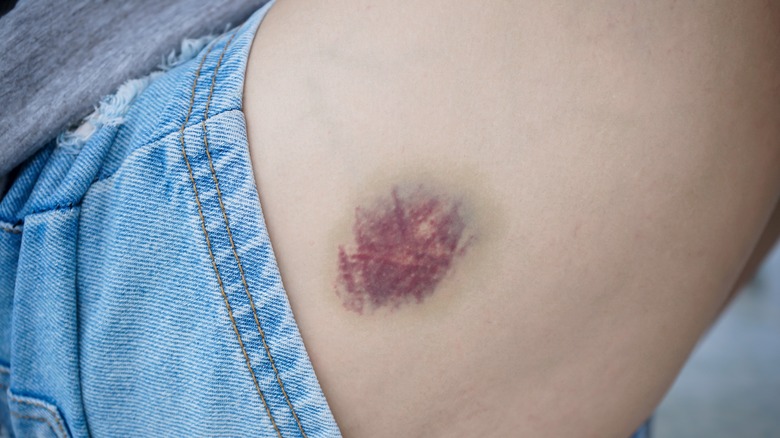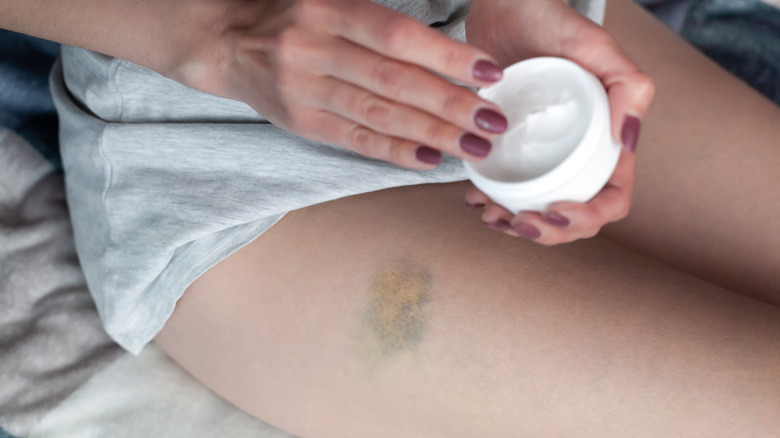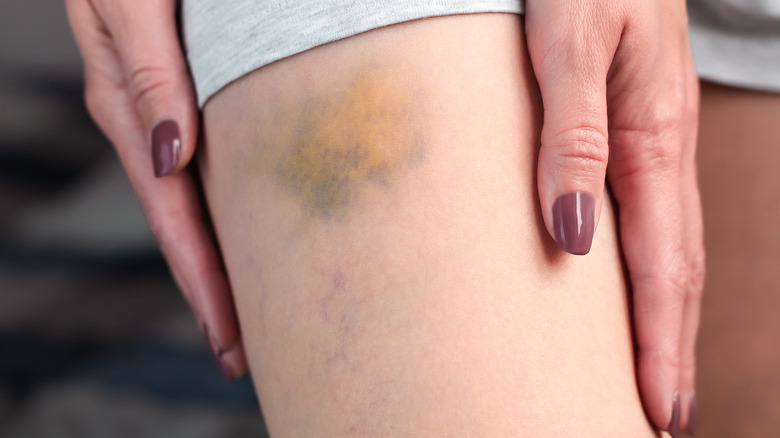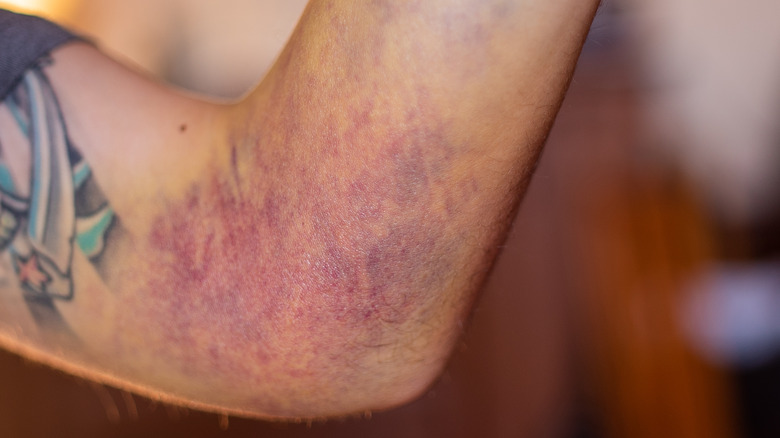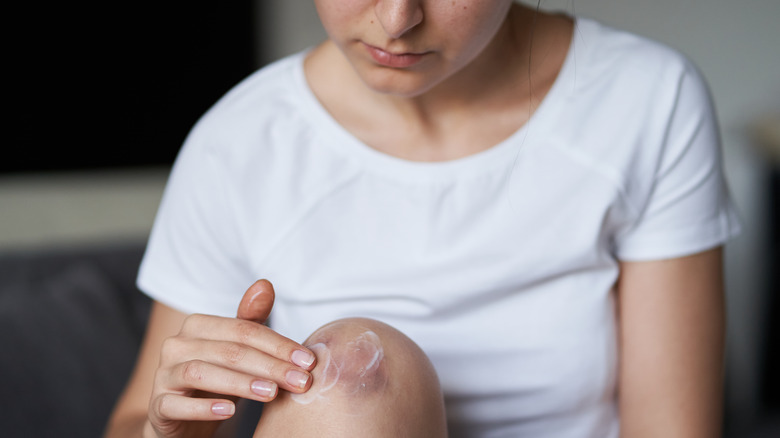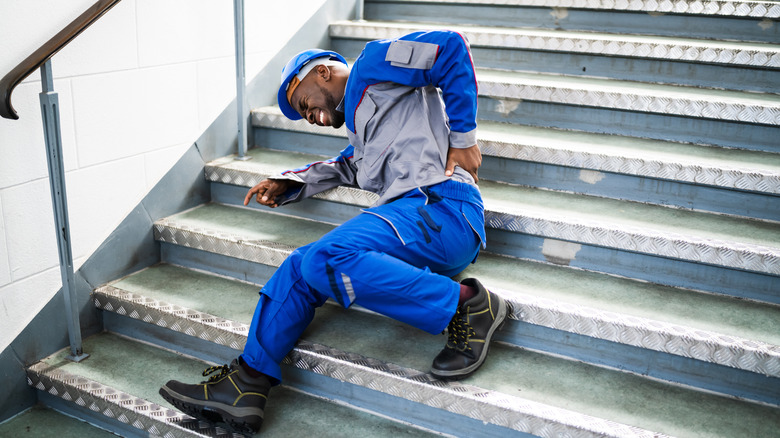Everything You Wanted To Know About Bruises
We have all had a bruise at some point in our lives. Some of us, especially those who participate in contact sports or have hardcore hobbies like kickboxing, have dealt with countless bruises. According to the Mayo Clinic, bruises happen when an injury causes the blood vessels right under the skin to break. These damaged blood vessels leak under the skin, and the blood pools, causing the bluish mark under the skin. The bleeding remains under the skin unless the skin is broken during or after the injury.
Contusions are a commonplace, everyday injury and in most cases, they're relatively harmless. However, they can cause quite a bit of discomfort depending on the type of bruise. Understanding the different kinds of bruises and how to treat them is essential to proper healing. To help you out, we've put together this guide on everything you've ever wanted to know about bruises.
Types of bruises
Though all bruises are the result of broken blood vessels below the skin, the appearance and severity of the bruise does differentiate one type from another. The Cleveland Clinic states that there are distinct types of bruises, also known as contusions, that are different from the common bruises you get when you bump into something.
A hematoma, for example, occurs as a result of a serious injury. With a hematoma, the broken blood vessels bleed so much that fluid builds up under the skin. This causes swelling and pain at the site of the hematoma and in surrounding tissues. If your bruise dramatically swells up soon after your injury, then you probably have a hematoma.
Purpura is a small bruise that occurs very close to the surface of the skin. This type of bruise is made up of small dots or patches, according to the medical professionals at Mount Sinai Hospital in New York. Purpura often looks more like a purple rash than a typical bruise. Though purpura can happen from an injury, it's more often a symptom of an underlying condition. A subtype of purpura, petechiae, shows up as tiny, red dots instead of larger purplish for or patches.
Older adults often develop what's called senile purpura. This type of purpura happens when the skin gets dryer and thinner, making it more fragile. This is a normal part of the aging process which makes older people more prone to bruises.
Serious types: black eyes, deep muscle, and bone bruises
A black eye is considered a separate type of bruise because the location causes additional medical concerns (via Cleveland Clinic). A black eye occurs when an injury to the face or head breaks the blood vessels surrounding the eye, causing blood to pool under and around the eye socket. Black eyes can be a sign of a more serious injury like a facial fracture or damage to the eye. Swelling around the eye can also obscure vision.
Another serious type of bruise is called a bone bruise. When the impact that caused the injury is more severe, the bone can actually bruise, much like the skin, according to the medical professionals at St. Luke's Hospital in Kansas City, Missouri. Though bones are made of different tissue than muscles or skin, they still contain blood vessels. When the blood vessels in the bones break, blood leaks into the surrounding tissue, causing a bruise.
Bone bruises usually cause more significant swelling than a regular bruise or even a hematoma. The soft tissue surrounding the bruised bone will often swell. If the injury was near a joint, the joint may swell as well, limiting your range of motion. Though bone bruises are more severe and often more painful than the other types of bruises, they usually don't require different treatment.
Additionally, when blood vessels deep within the muscle break, the muscle tissue can bruise like skin or bone (via Healthline). Deep muscles bruises are quite similar to bone bruises.
Bruises change color as they heal
Though the multicolored mural of an older bruise can be unsightly, the color changes are actually a sign that your bruise is healing. Dr. Michael Omori, director of the Pediatric Emergency Center at St. Vincent Mercy Medical Center in Toledo, Ohio, told Discover that the black and blue coloring we associate with bruises is a result of the blood from the blood vessels losing oxygen as it leaks into the surrounding tissues.
In order to heal a bruise, the body has to break down the blood that leaked from the broken blood vessels. As the body breaks down that blood, some of the elements are reclaimed and reused, while others are broken down and expelled. Most of the iron in the blood from the bruise is collected and eventually used to make new red blood cells. Most of the other building blocks of the blood cells are reabsorbed for later use as well.
The elements of the blood that can't be reused get broken down into new elements. First, those elements get broken down into biliverdin, which has a greenish hue. That's why a bruise often turns green as it starts to heal. Whatever remains is then broken down into bilirubin, which has a yellow or light brownish hue. That's why a bruise looks tan or yellow as it begins to disappear. When the blood from the blood vessels is all reabsorbed, broken, or excreted, the skin returns to its normal shade.
Bruises hurt as a result of inflammation
Dr. Rob Lamberts, a board-certified internal medicine and pediatrics physician who runs his own private integrative medicine practice, explained on his site that inflammation is the reason bruises hurt. When the blood vessels break and the blood leaks into the surrounding tissue, the blood cells signal the body to send white blood cells to the contusion. As the white blood cells break down the blood, they release substances that cause inflammation and trigger the body to send pain signals to the brain. The pain will subside as the inflammation goes away.
Although the pain caused by inflammation is unpleasant, an article published by the Institute for Quality and Efficiency in Health Care pointed out that it serves a specific purpose in the healing process for any injury. It's a reminder to be gentle with and protective of the injured area. This caution helps the existing injury heal and lessens the chance of reinjury. So, even though no one likes to be in pain, it's an important part of getting better!
Some swelling is normal
The inflammation kicked off by the white blood cells causes the tissue around the bruise to become puffy, pink or red, and warm or hot to the touch. This is called swelling. According to an article published by the Institute for Quality and Efficiency in Health Care, inflammation makes the blood vessels in the surrounding tissues wider so that more blood cells and immune system cells can flow to the injured area and help it heal. This leads to a buildup of excess fluids, which causes swelling. The swelling around a bruise should be minor unless there is a more serious injury.
As the immune system cells break down the blood from the broken blood vessels, they also flush the fluid out of the area. This causes the swelling to subside. So some swelling on or around the bruise is actually a good thing! It means that your immune system is doing its job. Swelling should subside within a few days of the injury.
Ice therapy
Luckily, managing pain caused by bruises is fairly simple. WebMD recommends putting an ice pack on the injured area as soon as possible after you get hurt. Putting ice on the bruise as quickly as possible will constrict the blood vessels. This will limit the blood flow in the area, which could mean less bleeding from the broken blood vessels, reducing the size of the bruise. Ice will also help calm down the inflammation, which will help reduce swelling. Don't forget to "protect your skin by wrapping the ice in a washcloth or paper towel," WebMD advised.
Though it may seem counterintuitive to constrict the blood flow to the area when this is necessary for healing, you're only doing this for a limited amount of time. Once you remove the ice, the blood vessels will open up again, allowing the white blood cells to do their thing.
Over-the-counter pain relievers help treat bruises
Over-the-counter pain relievers are a great way to deal with a painful bruise (via WebMD). Non-steroidal anti-inflammatory drugs (NSAIDs) will help relieve the pain and reduce swelling. So, ibuprofen, the main drug in Advil, and naproxen, the main drug in Aleve, are great over-the-counter remedies for a painful bruise. Aspirin is also an NSAID; however, according to John Hopkins Medicine, aspirin can increase bleeding, making it not a great choice in this case.
Acetaminophen, the main drug in Tylenol, will not help reduce swelling but it can provide pain relief (via Healthline). If you're in a lot of pain, you can alternate between acetaminophen and ibuprofen so you're not taking too many NSAID doses in one day, according to Healthline. Per Harvard Health, taking too many NSAIDs can actually cause easy bruising. Be sure to stick to the recommended dosage list on the bottle.
The healing process
According to Science in the News, a publication run by Harvard's graduate program, the healing process begins as soon as the injury happens. Platelets, the red blood cells responsible for clotting, rush to the wound as soon as it's detected. Their goal is to bunch together to form a clot, which stops the bleeding. The platelets also signal other immune cells to begin the inflammatory process.
The blood vessels then open up to allow reinforcements in. White blood cells called neutrophils are the first on the scene. Neutrophils check the wound for bacteria and then call in the monocytes, another kind of white blood cell. When monocytes arrive, they transform into another type of white blood cell called a macrophage.
The macrophages are responsible for cleaning and repairing the wound. These cells "eat" the damaged tissue and produce a substance called fibroblast growth factor that's used to rebuild the damaged tissue. Once the macrophages start the process of rebuilding the damaged tissue, the inflammation starts to resolve.
Tips to heal a bruise faster
Dermatologist Doris Day told Self that there's no magic way to get a bruise to heal immediately. Our bodies are very good at healing bruises, but they need some time to get the job done. That said, there are a few things you can do to give your immune system a helping hand. The first is to get an ice pack or a cold compress on the bruise as soon as you can. Day also suggested elevating the injured area as soon as possible. The blood that leaks from the broken blood vessels often collects around the injury, making the bruise bigger. As such, elevating the area to lessen the blood pooling can help keep the bruise smaller.
If you really want to speed up the healing time, you can consult a dermatologist. Day told Self that a dermatologist can use a specialized laser treatment to help break down the red blood cells faster. This can reduce the appearance of a bruise. However, it can have side effects that are comparable to a bruise, like redness, swelling, and soreness. Letting your bruise heal naturally is often the best option.
Arnica may be helpful
As the Memorial Sloan Kettering Cancer Center explained, arnica is a flower that's related to a sunflower. Certain parts of the plant are used to make supplements, creams, and gels, which purportedly help reduce inflammation. However, the evidence for arnica's effectiveness is mixed.
One study published in the Journal of the Royal Society of Medicine found that arnica was no more effective at reducing inflammation or pain in post-operative patients than a placebo. Similarly, Dr. Brett Kotlus, a New York plastic surgeon who did his own double-blind, placebo-controlled study on the use of arnica to treat post-surgery bruising, told Shape that "there was no benefit in comfort or bruising." Still, other research has found that arnica can help reduce the appearance of bruises and the inflammation they cause. A study published in The British Journal of Dermatology found that arnica was more effective than a placebo at reducing overall bruising from an injury.
While the jury is still out, it could be worth asking your doctor about since the side effects are minimal. According to Memorial Sloan Kettering Cancer Center, the only side effects are redness or swelling.
Bruises can take weeks to months to fully heal
Even though bruises are relatively minor injuries, your body still has to do a lot of work to completely heal. Medical News Today says that most bruises will begin to change color about five days after the initial injury. Remember, the color change is an important sign that your body is healing the bruise. As the neutrophils and macrophages break down the blood from the broken blood vessels, they convert them into biliverdin and bilirubin, which changes the color of the bruise.
About 10 days after the initial injury, the bruise should begin to fade, indicating that the tissue rebuilding process is almost complete. By two weeks after the injury, the bruise should be gone, indicating that it's completely healed. However, MedlinePlus points out that some bruises can take months to fully heal. It all depends on the severity of the bruise and how your immune system responds. The majority of bruises should heal within a few weeks.
When to see a doctor
Not sure whether bruising is a cause for concern? Bruises typically happen as a result of an impact to the body caused by a fall, a strike, or bumping into something. However, bruises that appear seemingly out of nowhere or bruises that happen from very light impact are unusual (via MedicineNet). Bruises that swell to the point of impacting your mobility, don't change color, fail to resolve within a couple of weeks, or continue to grow bigger may also be cause for alarm. MedicineNet terms these bruises as serious, and they require a visit to the doctor.
Unexplained bruises can be a symptom of an underlying medical condition, like a bleeding disorder (via WebMD). Additionally, bruises on a joint should get checked out by a doctor to ensure that there isn't any muscle, tendon, or ligament damage.
If you develop any symptoms of infection, like a fever, in addition to bruising or experience bleeding from your nose, ears, or mouth, contact emergency services immediately as this can be a sign of internal bleeding.
Some people just bruise easily
Though frequent bruises and bruising easily can be a symptom of something more serious, some people just bruise really easily for benign reasons. Prevention explained that common supplements like fish oil, vitamin E, ginkgo, garlic, ginger, feverfew, and saw palmetto can all have an impact on your red blood cells, which can lead to easy or frequent bruising. Since over-the-counter painkillers like ibuprofen and aspirin are blood thinners, they can lead to fragile blood vessels that break more easily. If you take an antidepressant, that could also be the culprit because selective serotonin reuptake inhibitors (SSRIs) interact with your platelets.
Women have less collagen in their skin, so they're more prone to bruising than men. Estrogen can also be behind easy bruising because it causes the blood vessels to open up, making it easier for blood to leak when the blood vessels break. Older folks are also more prone to bruising because skin becomes thinner and more fragile as we age. A lack of iron or vitamins C or K could even be behind your bruising, though it's unlikely if you're eating a balanced diet.
Bruises aren't entirely preventable
Unfortunately, bruises cannot be fully prevented. They're a normal response to an injury so, really, the only way to truly prevent them is to not get injured. The Cleveland Clinic says the best ways to prevent bruises are to make changes to your living area and wear protective gear whenever you're engaging in an activity that might lead to a fall.
If you frequently trip over or bump into things in your house, you can definitely rearrange so that you're less likely to have these accidents. Move furniture, pick up items from the floor, and make sure your cords are out of the way. Installing nightlights for those middle-of-the-night trips to the bathroom is another great way to avoid the bumps that cause bruises.
A balanced diet can also be an important part of bruise prevention. The University of Michigan's medical department recommends eating a variety of fruits and vegetables along with whole grains and plenty of protein to prevent vitamin deficiencies, which helps prevent bruising. Lastly, talk to your doctor about all the medications and supplements you're taking. Your provider may recommend changes to your regimen to address bruising.

